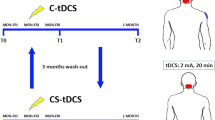Abstract
The aim of this study is to report on the clinical efficacy of epidural thoracic spinal cord stimulation on gait and balance in a 39-year-old man with genetically confirmed spinocerebellar ataxia 7. A RESUME Medtronic electrode was placed at the epidural T11 level. Spatiotemporal gait assessment using an electronic walkway and static posturography were obtained and analyzed in a blinded manner with and without stimulation. The Tinetti Mobility Test was also performed in the two conditions. At 11 months after surgery, there was a 3-point improvement in the Tinetti Mobility Test in the on stimulation condition, although there was no statistically significant difference in spatiotemporal gait parameters. Static posturography did not demonstrate a significant improvement in stability measures between the two conditions in a stochastic way. Thoracic epidural spinal cord stimulation had a mild but clinically meaningful beneficial effect in improving gait and balance in a patient with SCA-7. The underlying pathophysiologic mechanisms remain to be elucidated. Further experience with spinal cord stimulation in refractory gait disorders is warranted.
Similar content being viewed by others
References
David G, Giunti P, Abbas N, Coullin P, Stevanin G, Horta W, Gemmill R, Weissenbach J, Wood N, Cunha S, Drabkin H, Harding AE, Agid Y, Brice A (1996) The gene for autosomal dominant cerebellar ataxia type II is located in a 5-cM region in 3p12–p13: genetic and physical mapping of the SCA7 locus. Am J Hum Genet 59:1328–1336
Fenelon G, Goujon C, Gurruchaga JM, Cesaro P, Jarraya B, Palfi S, Lefaucheur JP (2012) Spinal cord stimulation for chronic pain improved motor function in a patient with Parkinson’s disease. Parkinsonism Relat Disord 18:213–214
Fong AJ, Roy RR, Ichiyama RM, Lavrov I, Courtine G, Gerasimenko Y, Tai YC, Burdick J, Edgerton VR (2009) Recovery of control of posture and locomotion after a spinal cord injury: solutions staring us in the face. Prog Brain Res 175:393–418
Fuentes R, Petersson P, Nicolelis MA (2010) Restoration of locomotive function in Parkinson’s disease by spinal cord stimulation: mechanistic approach. Eur J Neurosci 32:1100–1108
Fuentes R, Petersson P, Siesser WB, Caron MG, Nicolelis MA (2009) Spinal cord stimulation restores locomotion in animal models of Parkinson’s disease. Science 323:1578–1582
Gerasimenko Y, Roy RR, Edgerton VR (2008) Epidural stimulation: comparison of the spinal circuits that generate and control locomotion in rats, cats and humans. Exp Neurol 209:417–425
Harkema S, Gerasimenko Y, Hodes J, Burdick J, Angeli C, Chen Y, Ferreira C, Willhite A, Rejc E, Grossman RG, Edgerton VR (2011) Effect of epidural stimulation of the lumbosacral spinal cord on voluntary movement, standing, and assisted stepping after motor complete paraplegia: a case study. Lancet 377:1938–1947
Hassan S, Amer S, Alwaki A, Elborno A (2013) A patient with Parkinson’s disease benefits from spinal cord stimulation. J Clin Neurosci 20:1155–1156
Iwahara T, Atsuta Y, Garcia-Rill E, Skinner RD (1992) Spinal cord stimulation-induced locomotion in the adult cat. Brain Res Bull 28:99–105
Jilge B, Minassian K, Rattay F, Dimitrijevic MR (2004) Frequency-dependent selection of alternative spinal pathways with common periodic sensory input. Biol Cybern 91:359–376
Kegelmeyer DA, Kloos AD, Thomas KM, Kostyk SK (2007) Reliability and validity of the Tinetti mobility test for individuals with Parkinson disease. Phys Ther 87:1369–1378
Krauss JK, Weigel R, Blahak C, Bazner H, Capelle HH, Grips E, Rittmann M, Wohrle JC (2006) Chronic spinal cord stimulation in medically intractable orthostatic tremor. J Neurol Neurosurg Psychiatry 77:1013–1016
Lavrov I, Dy CJ, Fong AJ, Gerasimenko Y, Courtine G, Zhong H, Roy RR, Edgerton VR (2008) Epidural stimulation induced modulation of spinal locomotor networks in adult spinal rats. J Neurosci 28:6022–6029
Prieto TE, Myklebust JB, Hoffmann RG, Lovett EG, Myklebust BM (1996) Measures of postural steadiness: differences between healthy young and elderly adults. IEEE Trans Biomed Eng 43:956–966
Storey E, du Sart D, Shaw JH, Lorentzos P, Kelly L, McKinley Gardner RJ, Forrest SM, Biros I, Nicholson GA (2000) Frequency of spinocerebellar ataxia types 1, 2, 3, 6, and 7 in Australian patients with spinocerebellar ataxia. Am J Med Genet 95:351–357
Thevathasan W, Mazzone P, Jha A, Djamshidian A, Dileone M, Di Lazzaro V, Brown P (2010) Spinal cord stimulation failed to relieve akinesia or restore locomotion in Parkinson disease. Neurology 74:1325–1327
Tinetti ME (1986) Performance-oriented assessment of mobility problems in elderly patients. J Am Geriatr Soc 34:119–126
Yamaguchi T (1986) Descending pathways eliciting forelimb stepping in the lateral funiculus: experimental studies with stimulation and lesion of the cervical cord in decerebrate cats. Brain Res 379:125–136
Acknowledgments
The authors would like to thank Brent Geobey and Alex Valencia Mizrachi for their excellent technical support and support of the patient and his family. Patient consent obtained. Data sharing statement Dr. Moro has full access to all the data in the study and takes responsibility for the integrity of the data and the accuracy of the data analysis.
Conflicts of interest
Dr. Moro has received honoraria from Medtronic for lecturing. Dr. Lozano is a consultant for Medtonic, St Jude and Boston Scientific.
Ethical standard
All ethical standards for the conduct of clinical research met.
Author information
Authors and Affiliations
Corresponding author
Electronic supplementary material
Below is the link to the electronic supplementary material.
415_2013_7236_MOESM2_ESM.mp4
Video Segment 2 OFF stimulation condition, December 2012, with increased freezing and instability upon turning (MP4 8152 kb)
Rights and permissions
About this article
Cite this article
Sidiropoulos, C., Masani, K., Mestre, T. et al. Spinal cord stimulation for gait impairment in spinocerebellar ataxia 7. J Neurol 261, 570–574 (2014). https://doi.org/10.1007/s00415-013-7236-0
Received:
Revised:
Accepted:
Published:
Issue Date:
DOI: https://doi.org/10.1007/s00415-013-7236-0




